Introduction
Introduction: BSI sensor leads the way for APS-C chips
Announced early in 2015, the $800 Samsung NX500 offers a high-resolution 28.2Mp APS-C BSI-type sensor for detailed stills and 4K video capture. Adopting much of Samsung’s DSLR-style NX1 hybrid camera, the NX500 boasts some high-end features in a petite and compact shell. Its diminutive dimensions means there’s no room for a built-in electronic or flash unit, but the NX500 does feature a hotshoe for attaching external flash, including the low-power unit that comes supplied with the kit.
For those seeking out top-notch image quality from a small and lightweight camera, the development of Samsung’s BSI sensor technology is the big draw. With the sensor essentially flipped upside-down, enabling light to reach the photoreceptors more efficiently than with conventional sensors, a better quality of light can be recorded. With impressive scores posted for the Samsung NX1, our hopes were high for image quality on the NX500. So, without further ado, let’s analyze the results.
Key features & specifications
- 28.2Mp APS-C CMOS BSI sensor
- DRIMe V image processor
- NX AF II 205-point phase-detection AF
- 3.0-in AMOLED LCD
- 4K video capture at 24fps
- Expandable ISO 51,200 max sensitivity
- 9fps burst shooting
- Bluetooth, Wi-Fi & NFC connectivity
Measurements: Class-leading scores in all categories
With an impressive overall DxOMark Sensor Score of 87 points, the Samsung NX500 sits at the top of the DxOMark database for APS-C sensors alongside the Nikon D7200. For hybrid cameras featuring an APS-C sensor or smaller, however, the Samsung NX500 leads the way at the top of the table.
In fact, there’s clear distance between the NX500 with 87 points and the chasing hybrid pack, led by its sister model the Samsung NX1 with 83 points and the Sony APS-C A6000, NEX-7 and A5100 hybrids, all with scores in the low 80’s.
Posting the best scores for APS-C hybrids in all sub-categories, the NX500 offers around a half-stop better Color Depth and two-thirds of a stop better Dynamic Range compared to Sony’s best APS-C hybrid, the A6000. Against the Nikon D7200 semi-pro DSLR, the NX500 is also fractionally ahead for Color Depth, with a score of 24.8 bits compared to 24.5 bits for the Nikon.
It lags behind a little for Dynamic Range compared to the D7200, however, with scores of 14.6Evs for the Nikon vs 13.9Evs for the NX500. That’s around two-thirds off the pace compared to Nikon’s best and most expensive APS-C DSLR, but the NX500 actually offers similar Dynamic Range results to the Nikon’s best-performing entry-level DSLRs. The Samsung NX500’s Low-Light ISO score is good, too, sitting in second place — just fractionally behind the Nikon D5500 with a score of 1438 ISO, but again ahead of the rest of the Nikon APS-C competition.
The NX500’s high marks for APS-C sensor image quality are starting to bite at the heels of the full-frame Sony hybrid A7 series, too. Up against the lower-resolution 12.2Mp Sony A7S, also with 87 points, the NX500 actually offers better results for Color Depth and Dynamic Range, but can’t quite compete for Low-Light ISO.
It’s not far behind the 24Mp Sony A7, either, with similar recorded results for Color Depth and Dynamic range. There’s clear water between the NX500 and the super high-resolution 36Mp Sony A7R and 42Mp A7R II models, however, which offer around one stop better performance for color and low-light ISO at base ISO.
Samsung NX500 vs Sony A6000 vs Nikon D7200
With the same overall DxOMark score of 87 points, we can say that the Nikon D7200 and Samsung NX500 offer essentially comparable image quality for RAW files. There is a little variation in the performance in different areas, however, which could be important depending on what you shoot. The Nikon D7200 offers around two-thirds of a stop better Dynamic Range at ISO 100, for instance, which narrows to around one-third of a stop by ISO400. The D7200’s Dynamic Range remains around one-third of a stop ahead of the NX500 between ISO 400 and ISO 12,800, with results the same at ISO 25,600.
Conversely, although the Samsung NX500 is ahead of the Sony A6000 for Dynamic Range at lower ISO sensitivities, results converge by ISO 400, with both models displaying similar Dynamic Range between ISO 400 and ISO 6,400. If performance at the very highest sensor sensitivities is important, though, the Sony A6000 just jumps ahead of the Samsung NX500, recording greater Dynamic Range at ISO 12,800 and ISO 25,600.
In the Portrait sub-category, the Nikon D7200 and Samsung NX500 offer pretty much the same Color Depth throughout the sensitivity range. The NX500 does offer a half-stop advantage for color over the Sony A6000 between ISO 100 and ISO 800, however. Despite this, it’s fair to say that all three sensors offer good color — over 20 bits up to ISO 800, but if you’re looking for greater Color Depth at higher ISO settings, the Nikon D7200 and the Samsung NX500 have the edge between ISO 1600 and 6400.
For print results at SNR 18%, as sensitivity is increased, these top three APS-C sensors have almost identical results up to ISO 6400. The Sony A6000 offers slightly improved results at the highest sensitivities (ISO 12,800 and ISO 25,600), but the difference is going to be marginal in terms of real-world results.
Comparison 2: Samsung NX500 vs Sony A7 vs Sony A7R II
If you’re weighing the advantages of a full-frame hybrid compared to the best APS-C sensors, what do the sensor metrics tell us? Well, in summary, although the Samsung NX500 headlining scores aren’t far too behind at base ISO, the physically larger full-frame sensors improve as sensitivity is increased.
So while the NX500 boasts similar scores for Dynamic Range at ISO 100 compared to the A7 and A7R II, both Sony models jump ahead from ISO 400 onwards. In fact, the higher-resolution 42Mp Sony A7R II pulls away sharply as ISO is increased, resulting in around a two-stop advantage for Dynamic Range at higher sensitivities. That means that good Dynamic Range over 10EVs is achievable on the Samsung NX500 up to ISO 1600, but the Sony A7R II offers similar results at ISO 6400.
The trend is similar but not quite as pronounced for Color Depth, where the A7R II is ahead at base ISO and pulls away a little more as sensitivity is increased. Against the lower-resolution Sony A7, the NX500 actually offers the same Color Depth at ISO 100, with the Sony model improving just a little between ISO 400 and ISO 1600. So while good Color Depth over 20 bits is achievable on the NX500 up to ISO 800, the Sony A7 and A7R II offer similar results at ISO 1600 and ISO 3200, respectively.


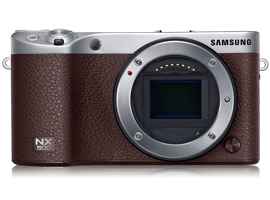



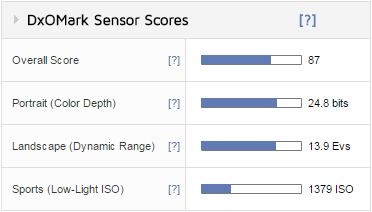
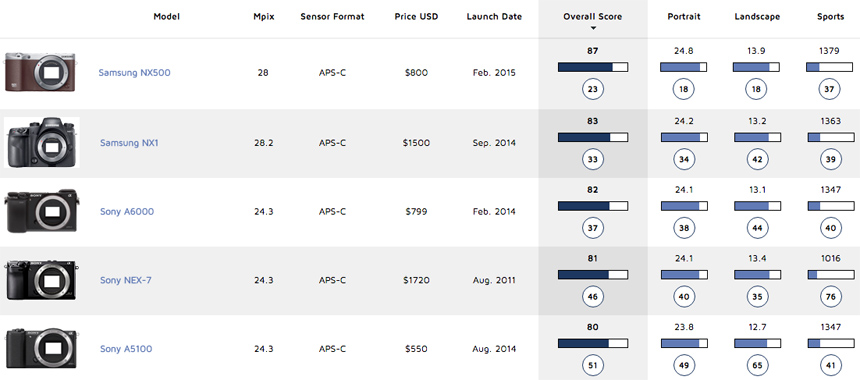
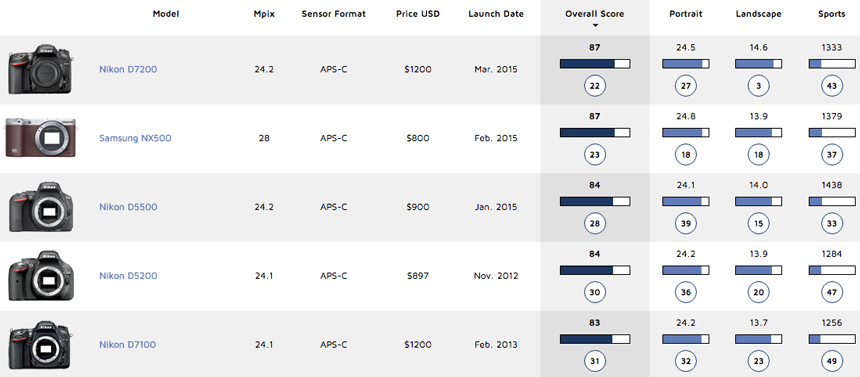
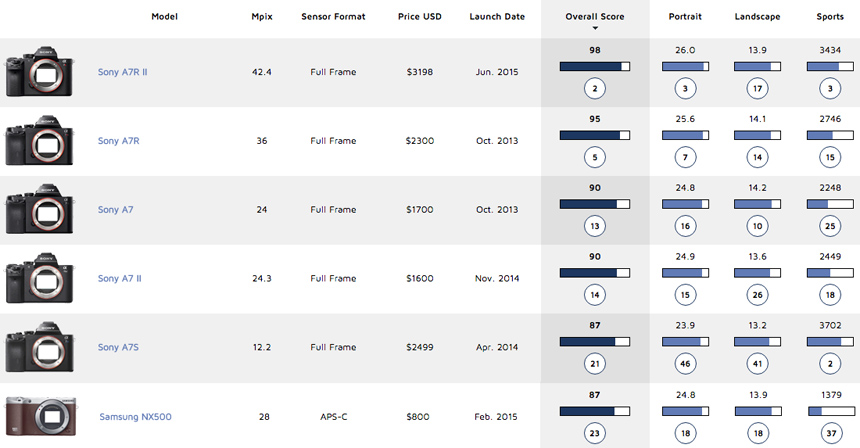
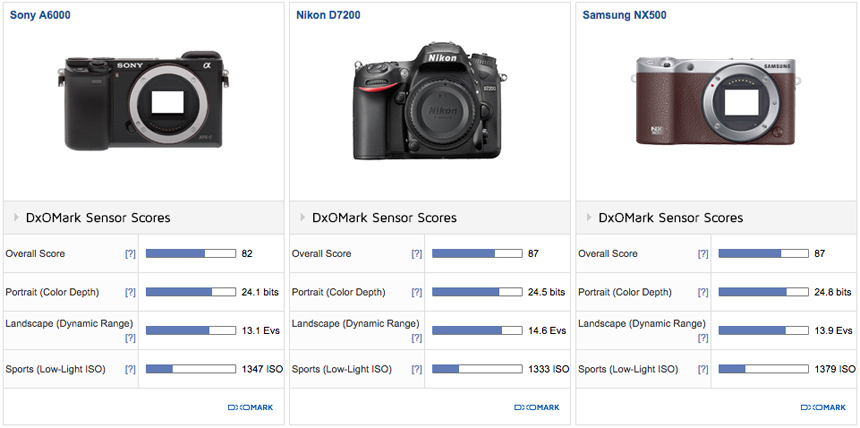
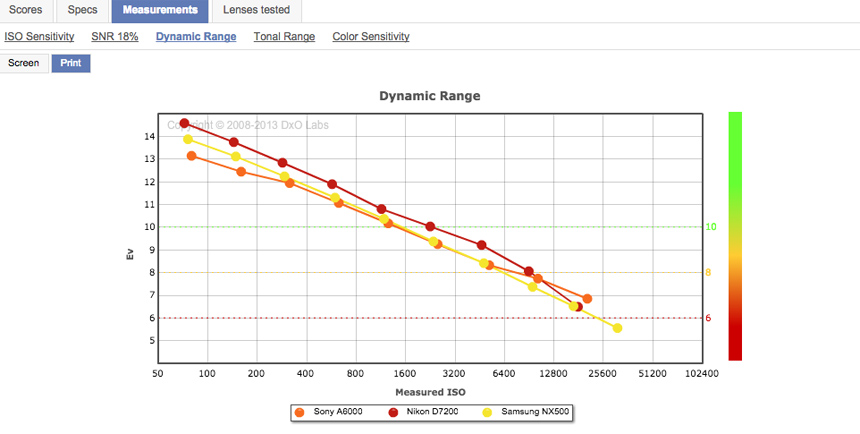
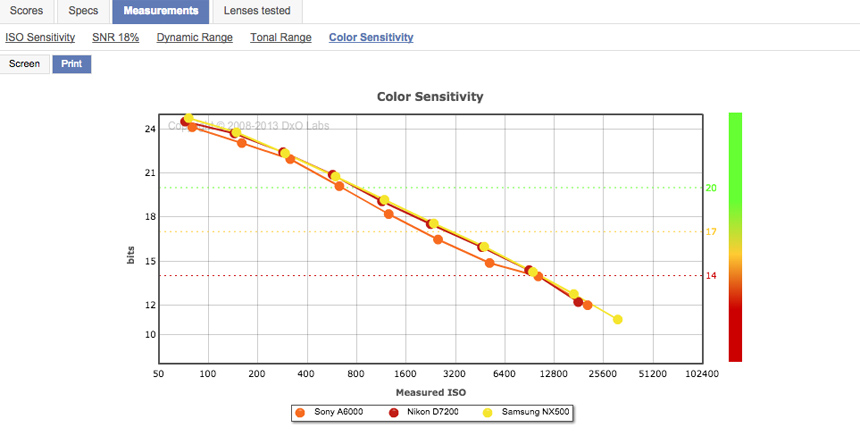
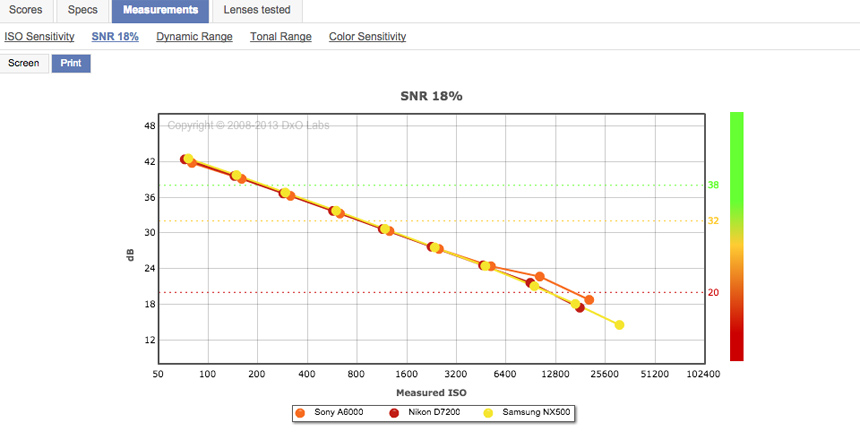
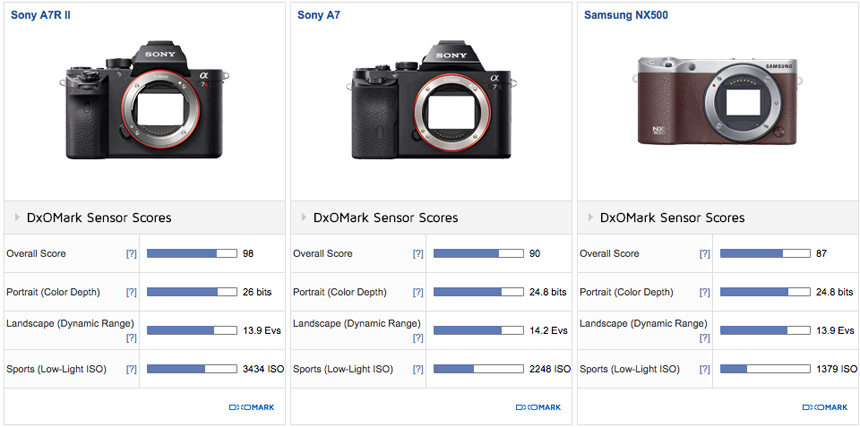
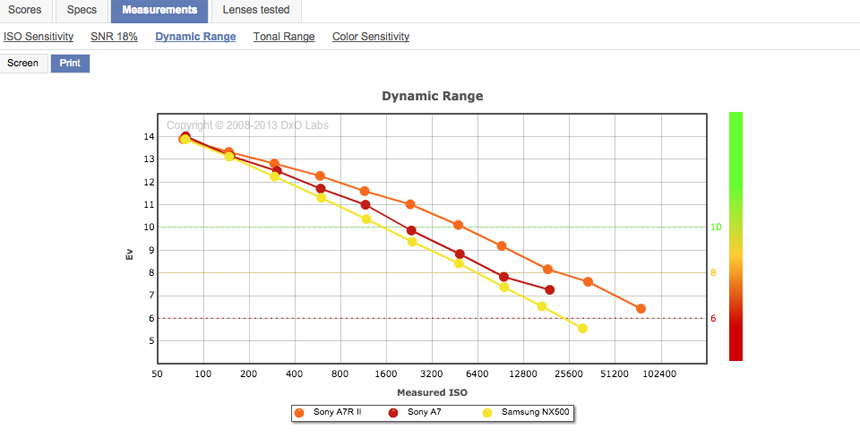
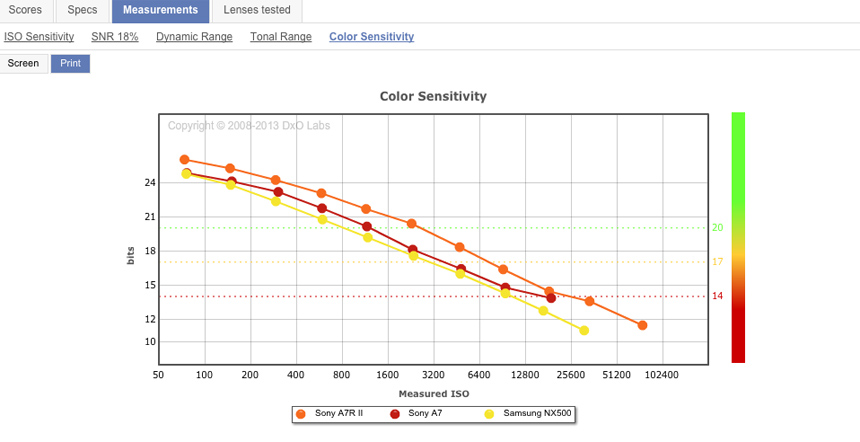
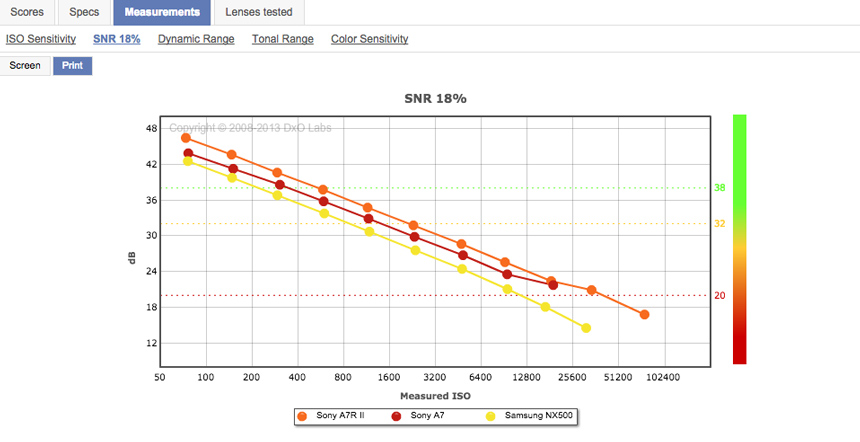
DXOMARK encourages its readers to share comments on the articles. To read or post comments, Disqus cookies are required. Change your Cookies Preferences and read more about our Comment Policy.